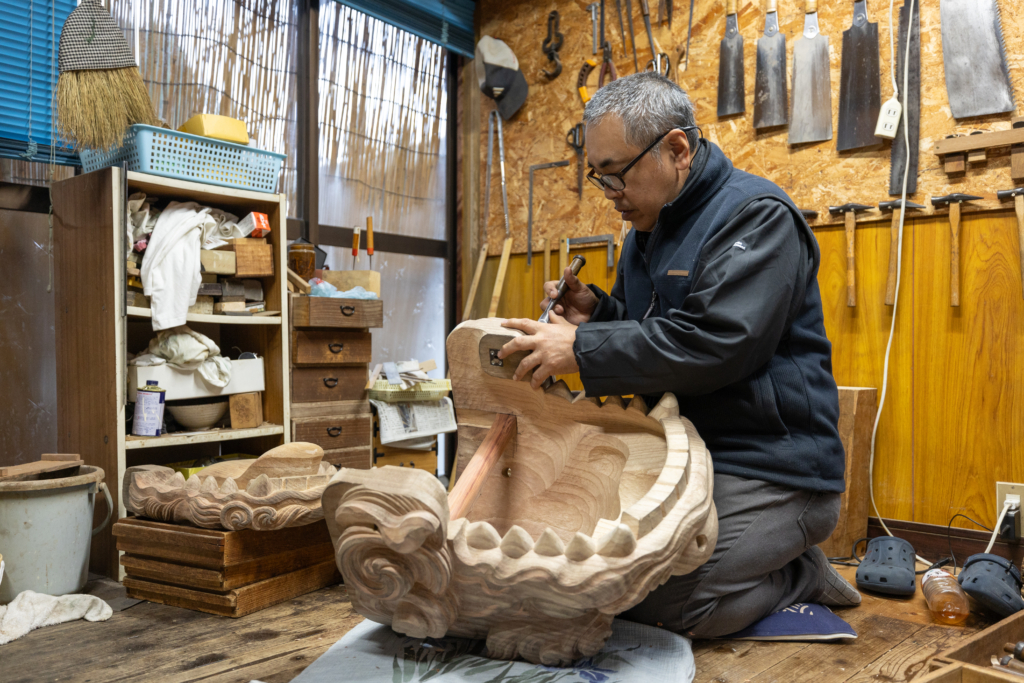
Crafting Lion Heads Living with the Community The Workshop’s Commitment to Preserving Tradition and Passing it on to the Next Generation
Located in Hakusan City, Ishikawa Prefecture, “Chida Kōbō” has been dedicated to the creation and restoration of Kaga Shishigashira (lion head) for over 70 years, preserving the tradition surrounded by the majestic nature of the region. We spoke with Seiun Chida, the second-generation craftsman, about the pride of supporting local festivals with his intricate techniques and the spirit embedded in each lion head.
Traditional Craft of “Kaga Shishigashira” Passed Down in Ishikawa Prefecture
Hakusan City, located in the southern part of Ishikawa Prefecture, is about a 30-minute drive from Kanazawa Station and has a population of approximately 110,000, making it the second-largest city in the prefecture after Kanazawa. The city covers a vast area stretching from the Hakusan Mountain Range, one of Japan’s three famous mountains, to the Sea of Japan. The Tedori River flows through the city, forming a fertile alluvial fan that is ideal for agriculture. This region is known for its active manufacturing industry, including machinery, automobiles, and textiles.
In Ishikawa Prefecture, the traditional “Shishimai” (lion dance) has been performed for centuries. Its origins date back to 1583, when the first lord of the Kaga Domain, Maeda Toshiie, entered Kanazawa Castle, and the people performed a lion dance in celebration. Over time, the successive lords of the domain encouraged it, and the Kaga lion dance developed into a magnificent traditional performing art.
The Kaga Shishigashira (lion head) has played an important role in festivals as a protective deity that wards off evil spirits and prays for good harvests and family safety. During the Edo period, with the support of the Kaga clan, craftsmen honed their skills, and the Kaga Shishigashira became known for its grandeur and strength.
The distinctive features of the Kaga Shishigashira are its use of paulownia wood and its luxurious design, adorned with gold leaf and lacquer. It also features a design called “Happō-neri,” where the eyes appear to be glaring from every direction. This symbolizes the power of protection against evil and is a crucial element of the lion head’s role as a guardian deity for the region. Additionally, the Kaga Shishigashira has horns, a unique feature not found in other regions. There is also a distinction between male and female heads, with the male having twisted horns and the female may have no horns.
Chida Workshop was founded by the first generation of Seiun Chida in 1954. Mr. Chida succeeded the name in 2022 and became the second generation of Chida Seiun. “Originally, my father was a craftsman who made paulownia chests and boxes. When we received an order to make a box for a lion head, he thought, ‘If we’re making it out of paulownia, why not try making the lion heads as well?’ and that’s how it all started,” Mr. Chida said.
It was a natural progression for Mr. Chida to take over the family business. The catalyst for his path as a craftsman came when his father gave him a piece of advice after he graduated from high school.
“My father told me not to stay at home but to go and train with other craftsmen first. At my training place, I learned about all types of sculpture and thoroughly studied the basics of wood carving.”
During his training, Mr. Chida not only learned wood carving but also studied Buddhist statues and contemporary art, which led him to incorporate modern improvements while preserving traditional techniques.
“What I learned during my training has greatly contributed to my current work. The approach of incorporating new ideas and techniques is something we always value at this workshop.”
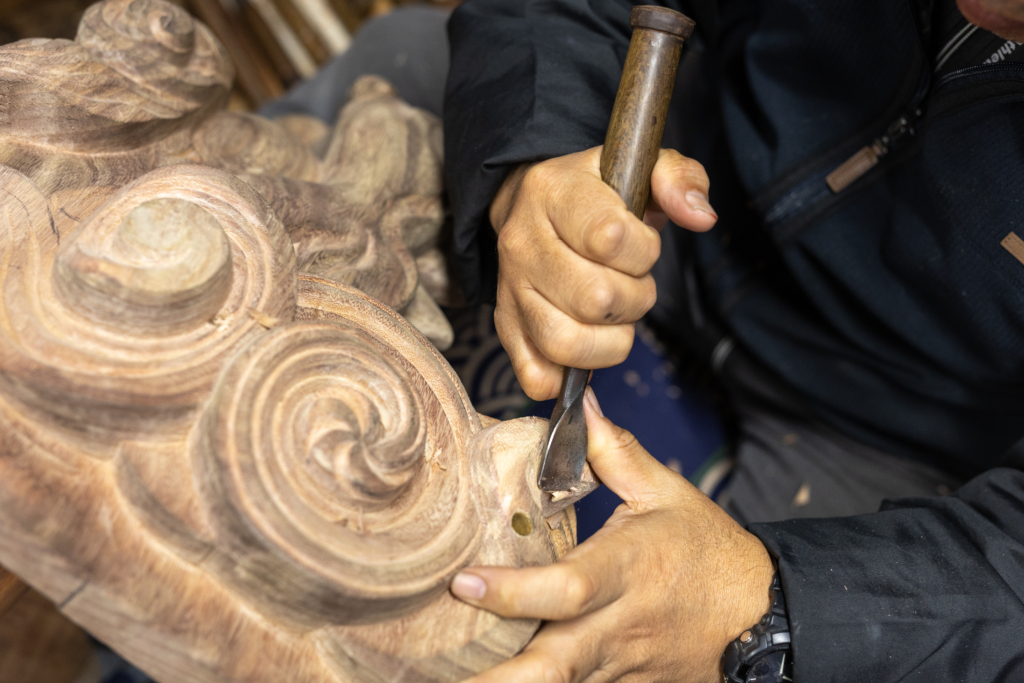
The Paulownia Wood Nurtured by the Foot of Mount Hakusan: Essential for Crafting Lion Heads
At Mr. Chida’s workshop, paulownia wood is primarily used as the material. The reason for this is its lightweight nature and ease of processing.
“Since the lion dance involves a lot of vigorous head movements, heavy wood would interfere with the festival. While paulownia wood is light, it is not ideal for wood carving, but I think being light is the most important factor.”
Paulownia is sourced from the foothills of Mount Haku in Ishikawa Prefecture, and its lightness and ease of processing make it perfect for crafting lion heads. In the past, many artisans in this area used paulownia to make products like geta (clogs) and chests, with woodworking and forestry supporting the local economy. However, today, the number of artisans working with paulownia has greatly diminished, and the supply of paulownia from the region has become scarce.
“In the past, there were many artisans who worked with paulownia, like those who made geta or paulownia chests. But now, there’s only one furniture maker and Chida Workshop left,” Mr. Chida reflects on the changes in the community.
Furthermore, the supply of paulownia wood continues to decline, with fewer people involved in logging and processing.
“In the past, when a daughter was born, they would plant paulownia trees, and by the time she got married, they would harvest the trees and make chests. But now, very few people plant paulownia. I must rely on lumber merchants to secure small amounts gradually,” he says.
However, securing paulownia wood is not an easy task. Finding the right wood for crafting lion heads requires significant effort, and the process begins with searching for suitable materials.
“Every face is different, so only certain parts of a log can be used. Even if you find a very thick tree, not all of it can be used. It’s also a challenge to identify the trees that should be felled in the forest,” Mr. Chida explains.
Additionally, drying the wood takes time. To bring it to the right state, several years of careful management are required. If the wood is dried too much, it becomes difficult to carve, and the timing of drying must be carefully controlled.
“If you leave the wood unused and let it dry out too much, paulownia wood becomes difficult to carve. It’s difficult to continuously secure high-quality paulownia,” Mr. Chida shares the challenges he faces in selecting the right wood.
While carrying on the legacy of the paulownia wood industry from the foothills of Mount Haku, Mr. Chida’s workshop continues to make use of the best materials for crafting lion heads. His efforts to secure paulownia reflect his passion as an artisan and his strong sense of responsibility towards the art of crafting these sacred masks.
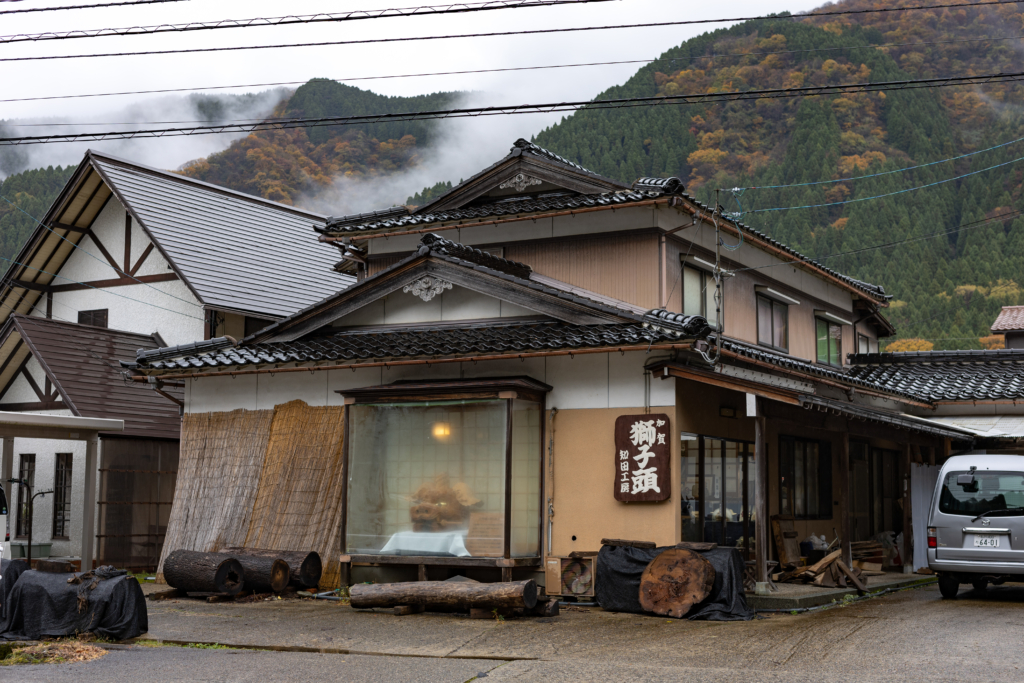
A Year-Long Crafting Process
It takes about a year to complete a single lion head. The reason for this lengthy process is that the production follows a division of labor, with several skilled artisans handling different parts of the process, each requiring their own expertise.
“Once the carving is done, it goes to the lacquer artisan, followed by metal reinforcement, and so on, with each craftsman contributing their skill. Managing the schedule to meet the local festival’s timing is extremely challenging,” says Mr. Chida. After the carved wood is handed to the lacquer artisan, it undergoes further reinforcement with metal parts. Since each stage requires time and skill, smooth collaboration between artisans is essential.
One of the most difficult aspects of the process is creating the “glare” of the eyes, which gives the mask its intimidating and powerful expression. “My father always told me that I needed to carve a scary face that could make a child cry, and this is the hardest part,” Mr. Chida shares. The eyes of the lion heads need to embody both the power to ward off evil spirits and a commanding presence, requiring delicate skill and expressive ability. Perfecting the “glare” is key to imbuing the mask with its vitality.
Additionally, while staying true to traditional carving techniques, Mr. Chida also incorporates new methods to achieve the desired balance of lightness and durability, ensuring that the masks can withstand the rigorous movements of the lion dance.
“A lighter mask allows for smoother movements in the lion dance, but it also needs to be durable enough to last for decades. I make sure to balance both,” explains Mr. Chida.
While preserving traditional techniques, Mr. Chida also utilizes modern reinforcement materials and durable paints to improve practicality. To reduce weight, the paulownia wood is carefully shaved, and weaker areas are reinforced with metal to ensure the masks can withstand the demands of the actual performance.
Throughout production, regular check-ins with the client are essential to ensure that the mask meets expectations. “It’s the best feeling when clients tell me that the mask looks just like the old ones, but it’s lighter and more durable,” Mr. Chida reflects on the satisfaction of the process.
The meticulously crafted lion heads, after passing through these detailed steps, not only embellish local festivals but also continue to support the community’s faith and attachment for many years. The production process is a testament to the artisans’ passion for preserving tradition and their sense of duty to pass it on to future generations.
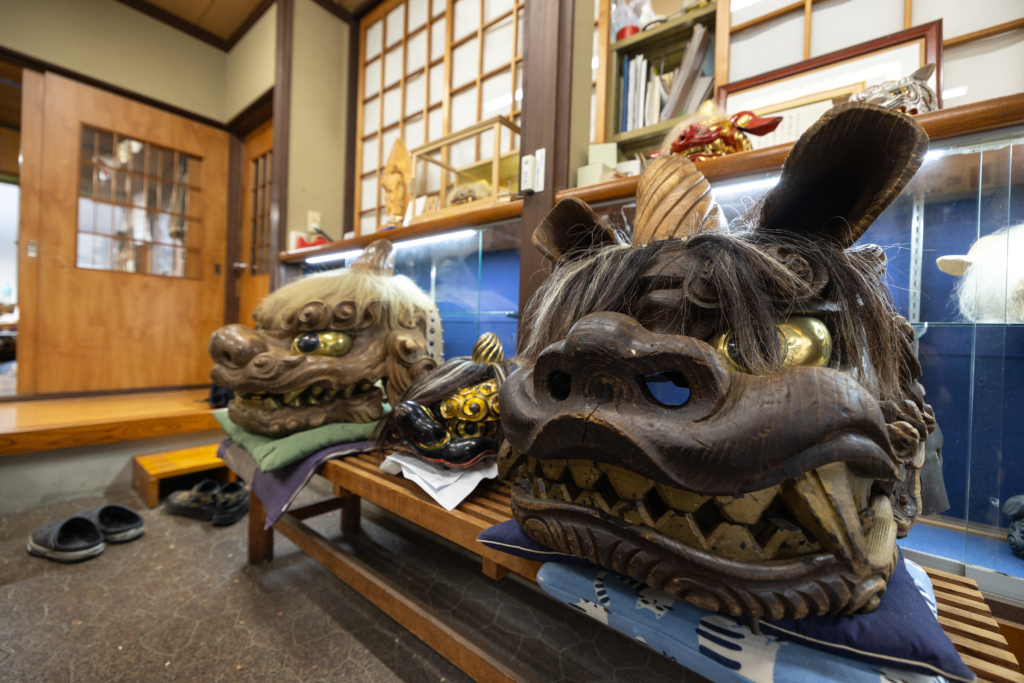
Restoration of Lion Heads Passed Down Through Generations
At Chida’s workshop, not only are new lion heads created, but old ones are also restored. The restoration work requires great responsibility and skill in preserving history. Many of the lion heads brought in for restoration were made during the Edo period.
“This large lion head here is from the Edo period, more than 200 years old. We restore not only old masks but also those from other regions. There aren’t many artisans who specialize in restoring lion heads,” says Mr. Chida.
Old lion heads are treasures of local history, and after many years, wear and tear or damage are inevitable. Mr. Chida works closely with the clients to restore the masks as faithfully as possible to their original state.
Restoration involves not only repairing the visual aspects but also ensuring strength and balance. Especially for older masks, since they are often used in festivals after restoration, durability is a key consideration. This might include reinforcing metal parts or re-coating with lacquer. Additionally, if a client requests that the mask be made lighter, techniques to reduce weight while maintaining strength are also required.
“Some lion heads made during the Edo period are still in use and are used in festivals. In such cases, durability and reinforcement are extremely important,” says Mr. Chida.
Since designs and decorations vary by region, a deep understanding of the local culture and techniques is essential for restoration. In some regions, special materials or techniques were used, which can make restoration particularly challenging.
“Each region has its own unique style of lion heads. For example, if a mask has bird feathers attached to it, restoring that becomes very difficult, so there are cases where we have to turn down the restoration,” Mr. Chida adds.
Through these restoration efforts, Mr. Chida continues to pass down the traditions and faith that have been preserved by the community for generations. Witnessing a restored mask shine once again in the festival is one of the greatest joys for a craftsman.
Passing on the Charm of Tradition to Children
Students at local elementary schools learn about lion heads as part of their curriculum, and sometimes visit Mr. Chida’s workshop.
“By allowing them to actually hold the lion’s head and explaining how they are made, we can spark their interest. It’s important for younger generations to understand the value of tradition,” Mr. Chida says.
In the workshop, children who visit are given the opportunity to hold the lion’s head and closely observe the intricate details, providing them with a hands-on experience of traditional craftsmanship.
“I let the children hold the lion’s head and explain their role. Seeing their surprise and growing interest when they encounter the masks up close for the first time is incredibly rewarding,” Mr. Chida smiles as he recalls.
“Elementary and middle school students come for educational activities. Each time, I teach them just how important the lion’s head is to our local festivals and traditions. Especially when middle school students visit, I strive to help them understand that this is a vital part of their local culture.”
Mr. Chida’s workshop is also committed to nurturing the next generation that will carry on the tradition. Mr. Chida’s son and apprentices are involved, ensuring the legacy continues through two generations.
“Having my son and apprentices continue this work is my greatest motivation,” Mr. Chida says.
Alongside traditional work, Mr. Chida and his team, including his son and apprentices, are also working on modern designs and developing new products. These efforts represent a forward-thinking approach that embraces innovation while preserving tradition.
Through explaining the tradition to local children and offering hands-on experiences in the workshop, Mr. Chida is deeply committed to passing down this cultural heritage to future generations.
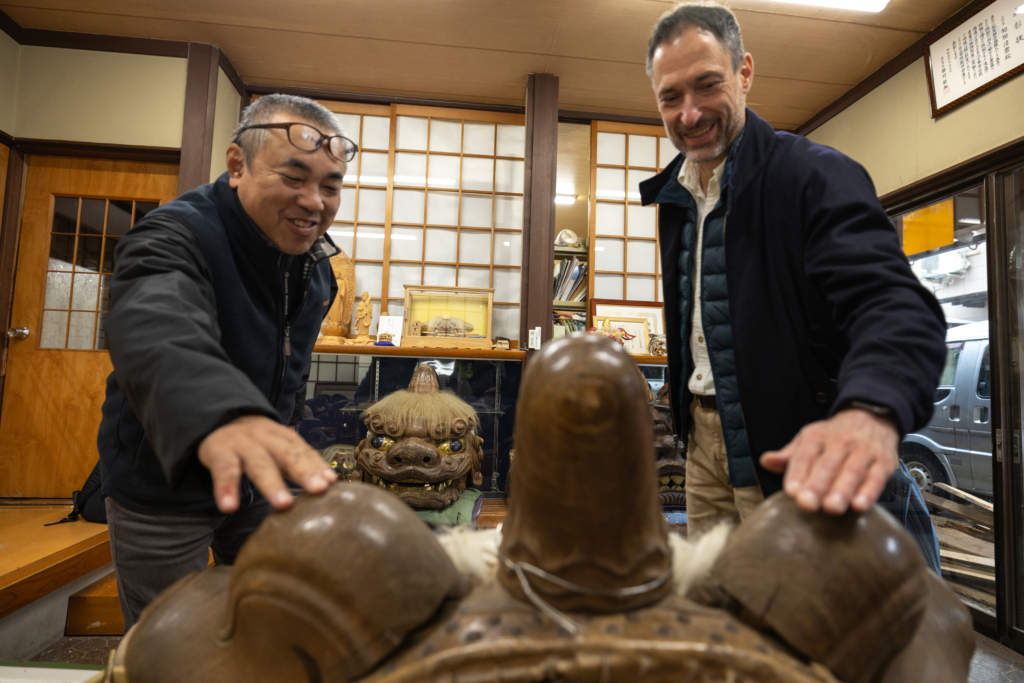
Rooted in the Community, Looking Toward the Future
Mr. Chida values the tradition of the lion’s head as a guardian spirit loved by the community, and he wishes to preserve it by adding new value to carry it into the future.
“The lion heads used in festivals inevitably deteriorate over time. Recently, some regions have even stopped holding festivals altogether. Still, I believe it is important to continue without letting the tradition fade away. To do this, I want to support the local festivals while making sure to properly teach the techniques and knowledge to my son and apprentices,” says Mr. Chida.
In a time when some local traditions and festivals are disappearing, supporting the culture as a lion head craftsman is an important mission for Mr. Chida.
Additionally, passing down the techniques of lion head making to the next generation is also an essential challenge.
“When I teach children about lion dances, I realize that I have to preserve this 400-year-old tradition for the next generation. I never thought about this when I was younger, but as I get older, I’ve come to believe that passing it down to my son and apprentices is my job,” he explains.
Continuing to preserve the art of lion head making, which has grown alongside the local culture, and passing it to the next generation is crucial. To do this, it is vital to protect the techniques and spirit that have been passed down and to steadily preserve the tradition. Mr. Chida’s sincere efforts are a solid foundation that will carry the community’s faith and pride into the future.
Seiun Chida
Born in 1962 in Hakusan City, Ishikawa Prefecture. As the second-generation owner of the Shishigashira Kōbō (Lion Head Workshop), he followed the path of a craftsman. After graduating from high school, he trained under a sculptor in Ishikawa Prefecture before returning to take over the family business. For over 40 years, he has specialized in creating Shishigashira, preserving the traditional use of paulownia wood while also making improvements such as reducing weight and enhancing durability, contributing to the development of local culture.
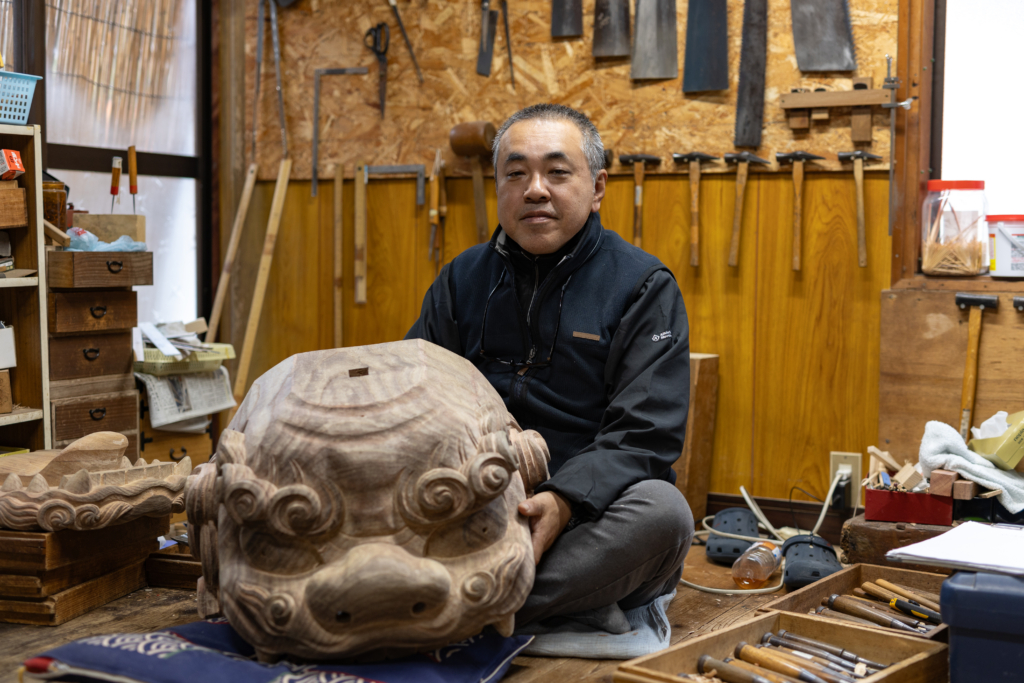
If you would like to visit the Chida Studio and further immerse yourself in the world of Kaga Shishi, please see the following information
【Chida Workshop Visiting Program】
Highlights
・Special visit to Chida Studio
・You can also buy handmade Kaga Lion souvenirs.
・You can also visit the Lion World Pavilion, located 3 minutes away by car, if you wish.
Information
Price: from 5,000 yen per person
Participants: 1 to 6 people
Duration: about 1 hour
Included: Tour of Chida Studio
Meeting: Parking lot of Chida Studio
Language: Japanese (English interpreter can be arranged upon request)
For reservation inquiries, please click here.